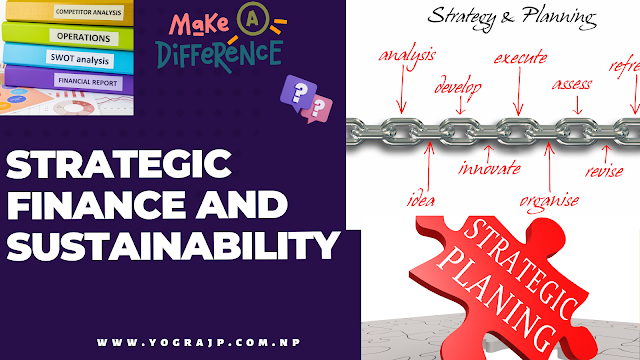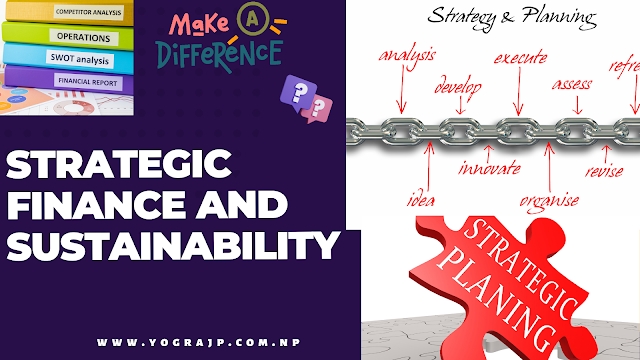Strategic Finance and Sustainability
 |
| Strategic Finance and Sustainability |
The notion of strategic finance pertains to making choices that assist the organization to enhance its cash flow in the long term. Strategic finance is about moving the emphasis from short-term earnings to long-term value development. On the other side, sustainability is about integrating more stakeholders in the value generation process. For instance, in the past, corporations simply existed to serve the interests of the stockholders. Over time, the mindset has evolved, and corporations increasingly aim to balance the interests of other stakeholders such as workers and suppliers as well.
Companies all across the globe are altering the yardstick they use in order to gauge their success. Instead than solely depending on earnings as the single gauge of performance, they now concentrate on the triple bottom line viz. profit, people, and the planet. The methods of strategic finance and sustainability are related to some degree. They are non-conventional in character and extend the perspectives of individuals. In this post, we will take a deeper look at how the ideas of strategic finance, as well as sustainability, are connected.
Sustainability and Strategic Finance share the same Goals
The notion of sustainability, as well as that of strategic finance, are fairly similar in nature. This is because they both steer the firm in the same direction. Most of the Fortune 500 corporations are already implementing sustainable financial strategies. This is because, in the long run, behaviors connected to sustainable finance are also practices that optimize the long-term worth of any organization. In the present world, firms cannot create profit for very long if they end up damaging the environment or any particular communities in the process.
Sustainability Lowers the Cost of Capital
The cost of debt that a corporation has to incur is directly connected to the risks it undertakes. Firms who do not comply with sustainable finance standards are susceptible to litigation and reputational problems. These risks eventually lead to monetary loss. All this raises the chance of loss and consequently diminishes the anticipated value. The final effect is that creditors start seeking for greater compensation in the form of increased interest payments. For instance, firms such as Shell or British Petroleum have had to pay significant amounts of money because of the environmental harm caused by the oil spills and other activities which impair the environment. Similarly, firms like Nike have faced litigation for allowing child labor in third-world nation sweatshops. On the other side, if a corporation adopts policies linked to sustainability, its chances of litigation and corresponding monetary losses are significantly decreased. Hence, the cost of debt is decreased by just implementing the policies.
Similarly, firms that implement strategies connected to sustainability also have a reduced cost of equity. This is because they willingly follow fair methods when it comes to dealing with workers as well as suppliers. Also, such firms tend to be overly concerned on product safety as well. These corporations would rather recall defective items and accept immediate losses than face reputational harm. Once again, this implies that the corporation suffers fewer worker strikes and the supply of raw materials is similarly consistent in nature. This ends up producing value in the long term by decreasing the cost of equity. Also, because vendors prefer to get payments on time, they do not factor in interest fees in the pricing of the products and services that they supply.
Since both the cost of debt as well as the cost of equity are reduced due to sustainable finance, the overall cost of capital becomes down. Lowering of the total cost of capital leads to an augmentation in the long-term discounted cash flow value of the company.
Sustainability Helps in Avoiding Volatility
The principles of sustainability mandate that the pace at which resources are consumed should be less than the rate at which these resources are naturally replenished. For instance, the pace at which gold and silver are used in the contemporary world should be less than the rate at which it is produced. If this criterion is satisfied, then the dangers of scarcity or abrupt surges in supply are essentially avoided. Since the supply is more or less consistent, the prices likewise tend to be stable. This helps enterprises minimize their cost of capital and allow the timely provision of their products and services to the end customer.
Sustainability Lowers Operating Costs
It is due of the efforts performed by pro-sustainability individuals that the dependency on fossil fuels has diminished throughout the years. Pressures from environmental organizations have led firms to transition to ecologically friendly sources of electricity such as solar or wind energy. These sources of energy are not only renewable but also free! Hence, if the technology is created which enables corporations to capture this energy, their total cost would be decreased. It may appear like natural sources are pricey in the near term. However, this will only be temporary due of the fact that the technology is not developed well enough. The advantages will undoubtedly be enjoyed in the long term.
The foregoing considerations explain why the ideas of strategic finance, as well as sustainability, are connected in the long term. The ideas of sustainable finance have already been accepted by the leading firms of the globe. It is about time that the smaller enterprises too start implementing the same.
More Articles are below:
- 1. Strategic Finance and Competitive Advantage
- 2. Strategic Finance and Capital Structure
- 3. What is Strategic Budgeting?
- 4. Strategic Capital Budgeting
- 5. Profit Maximization vs. Wealth Maximization
- 6. Strategic Financial Management’s Drawbacks
- 7. Advantages of Strategic Financial Management
- 8. The Strategic Financial Planning Process
- 9. Principles of Strategic Financial Management
- 10. Strategic Financial Management – Meaning and Its Functions

